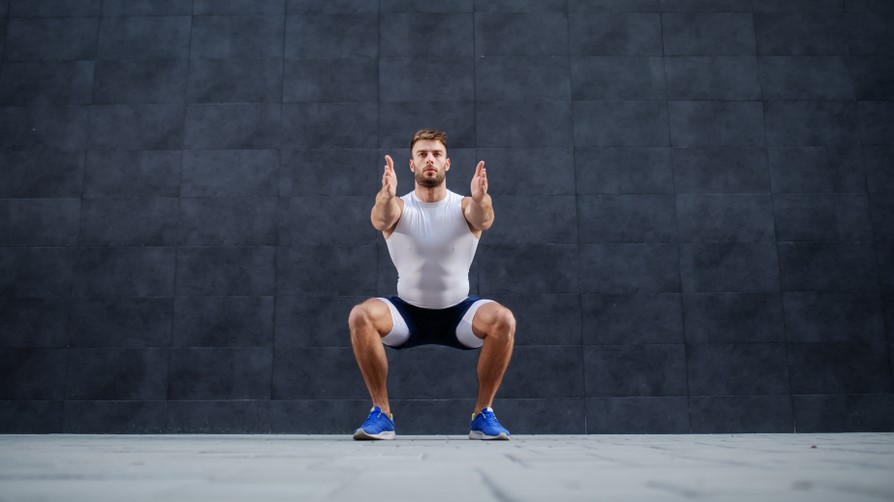I did 50 sumo squats every day for a week — here’s what happened
The regular squat works just fine, but this one makes you work much, much harder

I regularly add squats to my training regime, but I had not tried the sumo squat until my editor asked (told) me to try it for a week. And let me assure you, if you want to really target your glutes and your inner thighs, this is the one to go for. I’m a convert.
What is a sumo squat?
The sumo squat is named after the wide stance taken by a sumo wrestler just before he barrels into an equally gargantuan opponent and tries to shove him into the front row of spectators. It works the glutes, quads, hips, hamstrings, and, notably, the inner thighs (adductors). It also hits the calves (though you may not notice this, as you will be distracted by the fact your thighs are on fire) and you will need to engage your core to maintain form. In short, it’s an excellent lower-body exercise.
In terms of form, it’s not as easy as it sounds; however, once you’re comfortable with the mechanics of the move, you’ll almost certainly stick with it. You should begin using just your body weight, but you may want to add a dumbbell or kettlebell as you progress. Check out the best adjustable dumbbells for working out at home here, as well as the best home gym equipment.
How do you do a sumo squat?
If you are new to squats, you should start off with the regular front squat before moving on to this one. Walk before you run, squat before you sumo squat. When you are ready, stand with your feet wider than hip width apart. (Later, you can experiment with this distance to find your limit while maintaining form.) Now angle your toes away from your body—aim for about 45 degrees. Look down at your knees to ensure they are still directly over your feet.
Now, with your core engaged and hands loosely clasped together at chest height, push your hips back and bend at the knees to lower into a squat. Keep your back straight throughout and look forward. Continue to lower until your thighs are parallel to the floor. Engage your glutes and drive through your heels to return to start position, exhaling as you rise. That’s one rep. Start off with three sets of 10.

I did 50 sumo squats every day for a week — here’s what happened
I confess I was initially blasé about this move, so I raced through my first set, thinking my form would be automatically fine. At the end, however, I didn’t feel I had challenged my glutes any more than I would in a normal squat, and I felt nothing at all in my adductors. I decided to pretend day one had not happened while still taking on board the lesson.
On actual day one, I set myself properly—legs slightly wider—and lowered more slowly for the first few reps to ensure my knees remained in line with my feet. I also made sure to involve my glutes as I rose, rather than let the momentum and my quads carry the load. And it worked. In particular, I noticed the effort in my gluteus medius (the upper glute), quads and adductors.
Get instant access to breaking news, the hottest reviews, great deals and helpful tips.
On day two, I decided to hold the squat for a couple of seconds before rising. It sure added to the workout. It’s tempting to slip into a groove with this move, to squat and rise without thinking about form, but you’ll only get the benefit if you focus. Watch for your knees tracking left or right—or out over the top of your toes—make sure you push through your heels and don’t be tempted to throw in a hip thrust at the top of the move. Keep it smooth from start to finish.
By day three I was happy with my form, so I added 10 extra reps. I was slightly wobbly for a moment when I was done, but that seemed the right outcome. I was also feeling the move deeper in my adductors, which don’t get as much attention as they deserve.
On day four, I lowered deeper into the squat, which intensified the exertion level—I was breathing hard by the end. I decided that more variation was in order, so on day five I threw in a little jump at the top of the squat. If you try this, make sure you land lightly on your toes and do not sacrifice form. It’s a great way to mix cardio and strength work; if you are doing it at home, steer clear of chandeliers. Of course, if you have chandeliers, you probably also have someone to do your jumping for you.
On day six, I did the move while holding a 10lb (4.5kg) weight. You can either hold the dumbbell/kettlebell at your chest using both hands, as I did, or let your arms hang between your legs as you lower with the weight.
On day seven I tried it with the weight and the jump at the top. Only do this if you are completely sure of your form—it’s a tough one.
The sumo squat is a punchy, gratifying move and the option of adding a cardio element makes it all the more appealing. I could feel the effect in my glutes and inner thighs for hours afterwards and I find that kind of post-exercise temporary tightness to be reassuring. It will develop strength, build muscle, and ensure you never again groan as you get up out of a chair.
Looking for more workout inspiration? Read what happened when I did 30 supermans for a week here, and when I added 50 Russian twists to my daily workout for a week.
John is a writer and editor based in London. He was worked for magazines such as Runner’s World, Men’s Health, Women’s Health and Cosmopolitan. A keen runner, what he lacks in ability he makes up for with enthusiasm and excuses.

